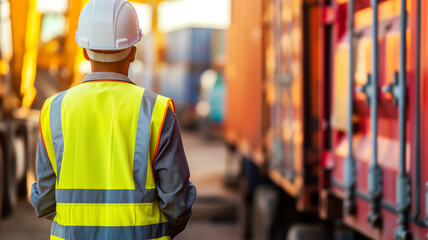In the vibrant tapestry of our daily lives, colors serve as more than mere visual stimuli. They convey messages, evoke emotions, and, in the case of high-visibility (hi-vis) wear, play a pivotal role in safety and communication. For those in environments where visibility is a matter of life and death, the choice of hi-vis color is more than a fashion statement—it’s a strategic decision that can impact safety protocols and job performance.
In this comprehensive exploration, we'll peel back the layers of hi-vis colors, unveiling the symbolic, practical, and safety-centric dimensions. We aim to empower construction workers, safety managers, and outdoor enthusiasts to make informed choices about the colors they don for high-risk working conditions.

Enhancing Safety and Branding with Reflective High Visibility Workwear
Reflective high-visibility workwear is a game-changer in enhancing the safety and visibility of individuals in high-risk environments. By incorporating fluorescent fabric and custom-printed reflective materials, these garments ensure that wearers are visible even in low-light conditions, significantly reducing the risk of accidents. Notably, the advent of printed hi-vis solutions has opened up new avenues for branding and diversified branding options, allowing companies to customise their high-visibility workwear with logos or messages. This dual benefit of increased visibility and branding opportunity makes reflective hi-vis wear an essential component of workplace safety protocols. Whether for construction workers navigating through dimly lit sites or road workers exposed to the hustle and bustle of traffic, these garments provide a critical layer of protection, ensuring that safety and corporate identity go hand-in-hand.
The Vital Role of Hi-Vis Colors
Before we plunge into the kaleidoscope of hi-vis shades, it's crucial to establish the integral role these colors play in our professional landscapes. Hi-vis wear is more than a regulatory requirement; it's a frontline defense against work-related accidents that can be exacerbated by low visibility.
Whether it's the bustling construction site, the expanse of a highway, or the dense undergrowth of a woodland, hi-vis colors are beacons that not only make us more noticeable but convey specific warnings and instructions. With this in mind, understanding the meaning behind each color is akin to learning a new language—one that can save your life.
Yellow Hi-Vis: The Universal Signal of Caution
Yellow, with its luminous warmth, is the most recognizable color of hi-vis wear. It's synonymous with caution and is widely employed in conditions where there's a need to attract attention without signaling immediate danger. Think of airport staff marshaling aircraft, signaling both to the pilots and the ground crew that caution is paramount.
The vibrance of yellow enhances visibility in low-light conditions, a testament to why it’s the go-to choice for most forms of outdoor and indoor work environments. Highways, loading docks, and crosswalks become safer as workers don yellows, ensuring that they're seen without invoking the jarring overtone of a red alert.
When to Wear Yellow:
-
General safety to ensure visibility during daytime and twilight hours
-
Ideal for indoor work environments with artificial lighting
-
Not to be worn in isolation during high-risk operations
Orange Hi-Vis: Navigating the Spectrum of Risk
Orange jumps into the arena when risks escalate beyond the cautionary yellow, acting as the intermediary between alert and alarm. In fishing, it often signals that a vessel is working with nets and lines. Similarly, in the construction sector, orange is the preferred hue for workers near moving equipment where accidents could be more severe.
The connotations of orange verge on the directive side, urging caution but doing so with a firmness that can’t be missed. Its hue is especially effective in foggy, smoky, or dusty conditions, making it the choice for environments where compromise in visibility is the norm.
When to Wear Orange:
-
Work near traffic or heavy machinery
-
Hazardous atmospheric conditions such as smoke, fog, or dust
-
Environments where clear delineation is necessary
Red Hi-Vis: A Call to Halt and Look
Red, the color that lies on the opposite end of the visibility spectrum, is no less assertive. It’s the universal hue of stop and carries an importance akin to a traffic light. In oil refineries, for instance, red signals areas where fire hazards are present and access needs to be strictly controlled.
Red is not only a stop sign for movement but a command to halt and evaluate the situation. When reaction needs to be instant and decisive, this color ensures that there is no ambiguity. Though not as bright as its yellow and orange counterparts, red still boasts high visibility, thanks to its propensity to stand out against most backgrounds.
When to Wear Red:
-
Prohibition zones and areas with imminent danger
-
Immediate action situations that warrant constant vigilance
-
Control and command centers for easy identification
Blue Hi-Vis: Breaking Convention with Caution
In hi-vis wear, blue is the non-conformist, the maverick that doesn’t easily fit into the preconceived categories of warning and alert. Traditionally associated with law enforcement, blue in hi-vis fashion often indicates a role that requires a heightened sense of attention without the immediate danger of other colors.
Airfield workers use blue to signify that a person is moving an aircraft, while some healthcare personnel don the hue to denote their roles. Blue's unique position in hi-vis wear speaks to its softer communication aspects—noticeable but not alarmist. Its presence suggests both professional presence and a request for passive awareness from those around.
When to Wear Blue:
-
Professions with a service and emergency response role
-
Settings where various factors demand moderate vigilance
-
Control points and zones with specific restricted access
The Role of Reflective Tape in Enhancing Visibility
Reflective tape is a critical component of reflective safety wear, serving as the unsung hero in low-light conditions. Strategically placed on hi-vis garments, this tape reflects light directly back to its source, making the wearer visible from considerable distances. This feature is especially vital during the twilight hours, or in environments where visibility is compromised by weather or lighting conditions. Reflective safety wear, adorned with high-quality reflective tape, ensures that workers, cyclists, and pedestrians stand out against any backdrop, significantly reducing the risk of accidents and enhancing overall safety.
The efficacy of reflective tape providing protection during low-light conditions cannot be overstated. By significantly increasing visibility, hi-vis vests and other garments equipped with reflective tape become pivotal in ensuring safety. Whether it’s in the realm of construction, road work, or any outdoor activity that extends into the dusk or dawn hours, these safety garments are designed to capture and bounce back light. This feature is crucial in environments where natural light fades, making it challenging to discern the presence of individuals. Thus, by wearing hi-vis vests that incorporate reflective tape, individuals are not only complying with safety standards but are actively contributing to a safer working and recreational environment, where the risk of accidents is considerably minimized.

Conclusion
The colors we choose for our hi-vis wear are not arbitrary; they are calculated decisions that reflect the complexities of the tasks at hand and the environments we operate in. Safety is not always in the hands of the individual but in the collective effort of an informed workforce.
Understanding the meaning of different hi-vis colors is the first step toward a safer workplace. It encourages dialogue, ensures compliance with industry standards, and most importantly, makes us more visible to those who, like us, must tread carefully in the world of labor and outdoors.
The next time you don your hi-vis gear, think not just in terms of fashion or regulation, but about the language your clothing speaks, the message it conveys, and the safety it secures. It's more than a layer of fabric; it's a vital component of your professional and personal narrative—one that deserves thought and respect.
